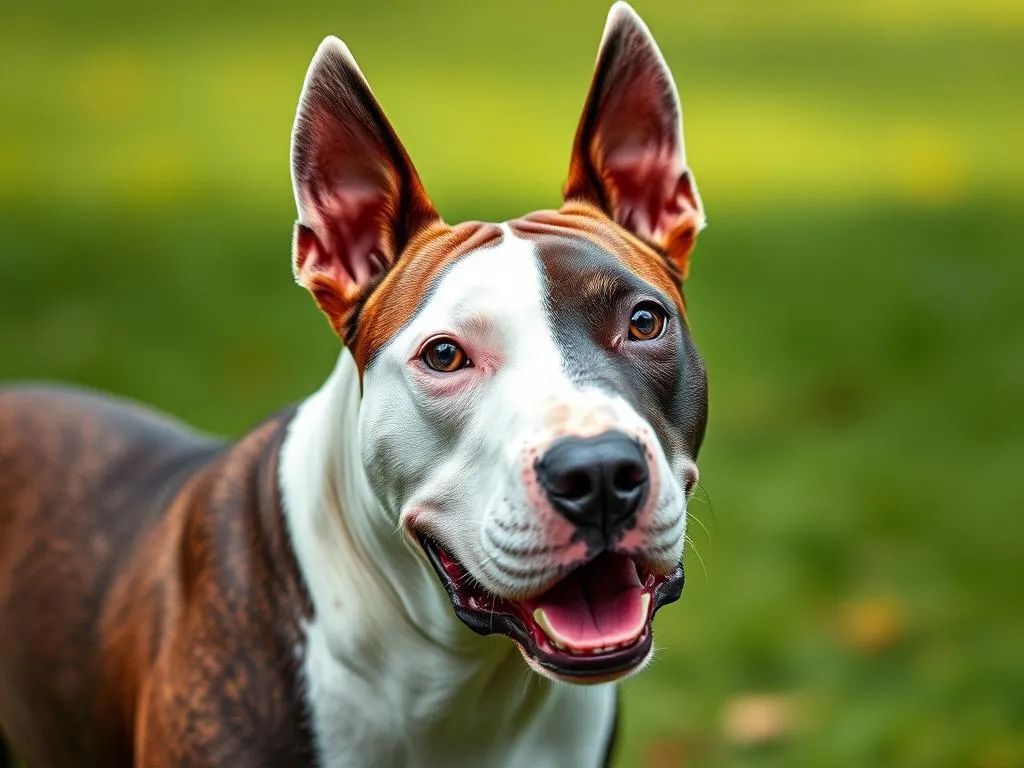
The Bull Terrier is a distinctive breed known for its unique appearance and vibrant personality. Originating in the early 19th century, this breed was developed primarily for bull-baiting and later became a popular companion dog. Over the years, Bull Terriers have gained recognition not just for their striking looks but also for their loyal and playful nature. Understanding the essential Bull Terrier facts is crucial for anyone considering adding one of these spirited dogs to their family.
History of Bull Terriers
Origin and Development
The origins of the Bull Terrier can be traced back to the early 1800s in England. The breed was created by crossing the now-extinct White English Terrier with the Bulldog. This combination was initially intended for bull-baiting, a brutal sport where dogs would confront bulls. Despite their controversial beginnings, the breed was gradually refined and evolved from its fighting roots to become a beloved companion.
Breed Recognition
The journey of the Bull Terrier toward recognition has been notable. The breed was officially recognized by the English Kennel Club in 1887. Over the years, the breed standard has evolved, focusing on temperament and conformation rather than fighting ability. The breed has seen various adaptations, including the introduction of the Miniature Bull Terrier, which was recognized by the American Kennel Club (AKC) in 1991.
Physical Characteristics
Size and Weight
Bull Terriers are medium-sized dogs. Adult males typically weigh between 60 to 65 pounds and stand about 21 to 22 inches tall at the shoulder. Females are slightly smaller, usually weighing between 50 to 60 pounds and measuring around 20 to 21 inches in height. Their robust build and muscular physique give them a powerful presence.
Coat and Colors
The Bull Terrier has a short, dense coat that is easy to maintain. They come in a variety of colors, including white, black, brindle, and fawn. Many Bull Terriers also have distinctive markings, such as patches or spots, which add to their unique appearance. The coat is generally smooth and requires minimal grooming, making them suitable for busy owners.
Distinctive Features
One of the most recognizable features of the Bull Terrier is its unique head shape, which is often described as egg-shaped. This distinctive head is complemented by small, triangular eyes that convey a strong, intelligent expression. Their ears are small and erect, giving them a playful and alert demeanor.
Temperament and Behavior
General Personality Traits
The Bull Terrier is known for its playful, affectionate, and loyal nature. These dogs are typically energetic and enjoy engaging with their families. They are often described as clowns due to their goofy antics and love for play. Despite their imposing appearance, they are known to be gentle and loving, making them excellent family pets.
Socialization Needs
Early socialization is critical for Bull Terriers. Exposing them to a variety of people, environments, and other animals from a young age helps ensure they grow into well-adjusted adults. Recommended practices include puppy classes, playdates with other dogs, and outings to different environments. This helps them develop confidence and reduces the likelihood of behavioral issues.
Interaction with Family and Children
Bull Terriers are particularly well-suited for families. They typically bond well with children and can be very protective. Their playful nature makes them great companions for kids, but supervision is essential, especially with very young children. Bull Terriers generally get along with other pets, but early socialization is crucial to foster positive interactions.
Health Considerations
Common Health Issues
Like all breeds, the Bull Terrier is prone to specific health issues. Some common hereditary conditions include skin allergies, heart issues, and deafness. Regular veterinary checkups can help identify these problems early, leading to better outcomes for the dog’s health.
Regular Health Checkups
Routine veterinary care is essential for maintaining your Bull Terrier’s health. Regular checkups, vaccinations, and preventative treatments can help catch potential health issues before they become serious. Keeping your dog up to date on vaccinations is crucial, as it protects them from various diseases.
Lifespan and Aging
The average lifespan of a Bull Terrier is around 10 to 14 years. As they age, they may face more health challenges, including arthritis or weight gain. Providing a well-balanced diet, regular exercise, and routine veterinary care will help ensure your Bull Terrier remains healthy and happy well into their senior years.
Training and Exercise Needs
Basic Training Tips
Training is vital for a Bull Terrier, as they are intelligent but can also be stubborn. Consistent and positive reinforcement techniques work best. Basic obedience training, including commands like sit, stay, and come, should be established early. Socialization classes can also be beneficial in teaching them proper behavior around other dogs and people.
Exercise Requirements
Bull Terriers require regular exercise to maintain their health and happiness. Daily walks, play sessions, and interactive games are essential for their well-being. Aim for at least 60 minutes of exercise each day, which can include walks, fetch, or agility activities. Engaging with them physically helps burn off their abundant energy.
Mental Stimulation
In addition to physical exercise, mental stimulation is crucial for a Bull Terrier. These dogs thrive on challenges, so incorporating puzzle toys, training exercises, and interactive games can help keep their minds sharp. Engaging in activities that require problem-solving will keep them entertained and reduce boredom.
Grooming and Maintenance
Grooming Routine
The grooming needs of a Bull Terrier are relatively low. Their short coat requires brushing once a week to remove loose hair and maintain a healthy shine. Bathing should be done as needed, typically every few months or when they become particularly dirty. Basic grooming tools like a slicker brush and dog shampoo are sufficient for their care.
Dietary Needs
A well-balanced diet is crucial for your Bull Terrier‘s health. High-quality dog food, whether dry or wet, should be chosen based on their age, weight, and activity level. Look for foods that list meat as the primary ingredient and avoid fillers like corn or soy. Consult your veterinarian for specific dietary recommendations tailored to your dog’s needs.
Hydration and Care
Ensuring your Bull Terrier has access to fresh water at all times is essential for their health. Hydration is especially critical during hot weather or after exercise. Additionally, be mindful of their water intake, as dehydration can lead to serious health issues.
Living with a Bull Terrier
Ideal Living Conditions
The Bull Terrier is adaptable and can thrive in various living conditions. Whether in an urban apartment or a rural home with a yard, they need enough space to move and play. Regular outdoor time is essential, so having access to a secure area for exercise is beneficial.
Compatibility with Other Pets
While Bull Terriers can get along with other pets, their compatibility often depends on early socialization and training. They may exhibit prey drive towards smaller animals, so careful introductions are necessary. Monitor interactions between your Bull Terrier and other pets to ensure positive relationships.
Travel and Outdoor Activities
Traveling with a Bull Terrier can be enjoyable, provided you take some precautions. Ensure they are comfortable in the car, and consider bringing a crate or seatbelt harness for safety. Outdoor activities like hiking, swimming, or visiting dog parks can be great ways to bond with your Bull Terrier. Just ensure they are always supervised and kept on a leash when necessary.
Conclusion
In summary, understanding essential Bull Terrier facts can significantly enhance your experience as a potential owner. These dogs are lively, loving, and loyal companions that thrive on human interaction and engagement. They require regular exercise, mental stimulation, and socialization to flourish. Owning a Bull Terrier comes with responsibilities, but the rewards of their companionship and affection are immeasurable. Consider adopting from shelters or rescues if you’re ready to welcome a Bull Terrier into your home. With the right care and understanding, a Bull Terrier can bring joy and love to your family for many years.









